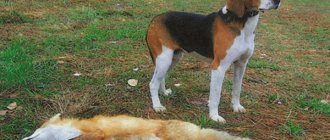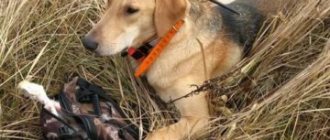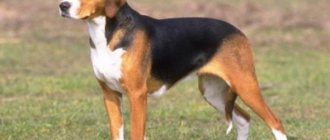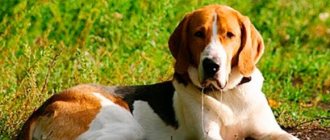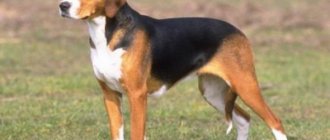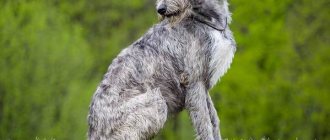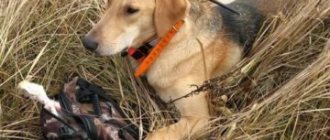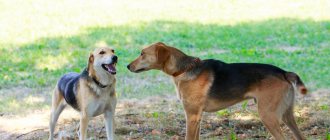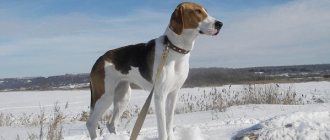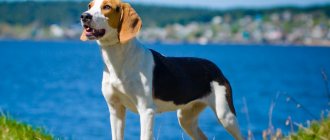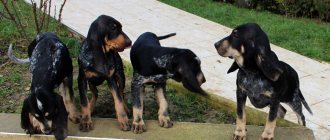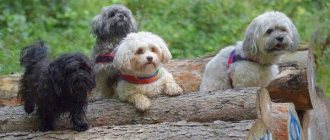It's no secret that the main entertainment of the aristocratic nobility in Tsarist Russia was hunting, so elite breeds of hunting dogs were held in high esteem. This means that there was a need to breed new breeds and improve old ones. It is worth saying that the work of the breeders was not in vain, and such a breed of dog was bred as the Russian Piebald Hound (RPG).
- 2 Features of the appearance and character of the Russian pet
2.1 Breed standard - 2.2 Pet character
- 4.1 Video: Russian pinto puppies on a walk
- 5.1 Training and raising a pet
5.1.1 Video: RPG while hunting a hare
Care and maintenance
Keeping them in an apartment is possible, but not advisable, as there are a number of difficulties associated with this. So, the pet will need to be provided with long, frequent walks and space for active games. However, it is better to keep hound dogs in a spacious enclosure where they have enough space to move freely. The size of the enclosure should be at least 15-20 m², it should be equipped with a roof that protects from rain and a wooden floor. It is advisable to make 3 wooden walls, and weld the last one from metal rods.
There should also be a booth in the enclosure. It may consist of not very thick walls, but they must be without cracks so that the dog does not get blown through. The size is selected individually: the animal must be able to stretch its paws, but there is no need to create a lot of free space, otherwise the hound may freeze in cold weather. For insulation, it is recommended to cover the walls of the structure with insulating materials.
If a dog howls in its enclosure, this may indicate its need for a walk. The characteristics of the breed suggest that the animal needs long, active walks; without them, it can easily get bored and begin to be capricious.
The breed does not require special care. It will be enough to brush the coat regularly. During the shedding period, this must be done once every 2-3 days to remove dead hair. It is enough to bathe a Russian hound 3-4 times a year, since the dog itself is clean.
Feeding
The animal is unpretentious when it comes to food and happily eats both premium and super-premium industrial food, as well as natural food. If owners decide to feed natural food, the animal's diet should contain:
- raw or cooked meat;
- boiled or stewed fish without bones;
- cottage cheese;
- cheese;
- porridge made from rice, buckwheat or oatmeal.
You can give small bones, but always raw, as boiled ones are less digestible
Also, when feeding naturally, it is important to include vitamin supplements, beef bones, etc. in the diet.
What to feed a puppy
Complementary feeding should be introduced from 1 month of life, before that babies feed on mother's milk. At this time, you can feed the puppy soups, cereals, and finely chopped raw meat. The puppy's weight should reach 5 kg for boys and 4 kg for girls. After the animal is 2 months old, it is necessary to add raw bones and cartilage to the diet, thanks to which calcium will enter the body. It will also help teeth erupt.
Be sure to choose lean meat for your dog - chicken or turkey. You can sometimes give an omelet, which is well absorbed by the body and is healthier than raw eggs. Meals should also include finely chopped vegetables, fruits and cottage cheese, rich in calcium. Sometimes add rye bread to meat broths. If owners prefer dry food, it is advisable to soak it in water at first to make it easier for the puppy to chew. Also, there should always be a bowl of clean water nearby.
How to choose a puppy and its price
The baby Russian hound inherits the exterior, character, and working abilities of its parents. Therefore, it is advisable to get acquainted with the female and male in advance, and see the litter from the first days.
To exclude possible defects, study the pedigree of the dogs - it is especially important to check if there are silent dogs in the family, or overly aggressive species that attack domestic animals. Next, examine the puppy:
Next, examine the puppy:
- The bite should be a scissor bite with the jaws in proper proportion (one jaw should not be larger than the other).
- The nose should be strictly black with no pink splashes.
- A purebred baby's eyes should be dark brown.
- The puppy should be strongly built, with thick legs.
- The baby's activity plays an important role.
- Finally, evaluate the level of instinct - with a good sense, still blind babies can find their mother’s nipples without any problems.
Elite specimens with exceptional pedigree can cost from $500 to $1000.
When choosing a baby, decide on the goal: if you need a devoted hunting companion, you can safely take a puppy with minor defects in the exterior.
For breeding, you need to purchase puppies with the best performance.
Maintenance and care
Russian piebalds are dogs that are well adapted to any weather conditions. They are not particularly demanding in terms of care, but some rules must be followed.
The animals are distinguished by their beautiful appearance and good working qualities.
Hygiene
It is necessary to bathe the dog only when necessary; puppies are not washed until they reach the age of three months. During shedding, it is necessary to comb the fur
It is important to monitor your pet's eyes - they are susceptible to conjunctivitis. They are washed with special solutions
Ears are examined and cleaned as needed.
Nails are trimmed only if the dog does not have time to sharpen them on his own.
Walking, physical activity and rules of safe behavior on the street
The Russian Hound is a very active dog. You need to walk with her at least three times a day, even if the dog lives in an enclosure. Animals need constant physical activity, long runs and active games in the fresh air.
Note! Walking without a leash is allowed only in deserted areas. In addition, you need to make sure that cats or small animals do not appear and the dog does not start hunting for them.
Features of feeding and diet
It is best to give such dogs lean raw meat along with cereals and vegetables - this is the best diet option. During the hunting period, there should be more meat products or by-products in the diet.
It is allowed to give the dog fermented milk products, cheese, rye and wheat crackers.
Dogs need to spend long periods of time outside, running and playing a lot.
Education, training, training
Russian hounds have high intellectual indicators: they are smart, intelligent and do not need numerous repetitions of the same command. Moreover, the diligence of the breed and its spiritual unity with the owner during the hunt have become a legend. On the other hand, inside every dog there lies a cunning dominant, ready at any moment to change the demands of its teacher. Training is also somewhat hindered by the breed's innate workaholism - in order to feel in good shape, the Russian hound needs to give all its best physically. Before you start training, take your pet outside and let him practice detective work and chasing. There is no point in training a Russian hound that sleeps and sees when it will be taken out for a walk. The dog will stubbornly avoid work until it begs for exercise in the fresh air.
The Russian hound begins to prepare for hunting at 3-4 months. At this age, the puppy is taught proper manners and accustomed to the sound of a hunting horn. It is advisable to lock the baby before each meal and blow the horn. Gradually, the Russian hound will understand the connection between the sound of the horn and the bowl of food, which will help it respond to the signal with lightning speed when hunting
It is equally important to restrain the dog’s natural instincts by training it in restraint and politeness. In particular, you should not allow the puppy to immediately rush to the bowl of food: a well-mannered baby should start eating only with the owner’s permission
Of course, driving an animal away from treats by wooing it with an oar, as was done in the old days, is fundamentally wrong, but it is still necessary to slow down the impatience of the rogue. Otherwise, when the puppy begins to fully hunt, you will have to be content with exhausted hares and holey fox skins.
As for training the breed, standard methods are used for the entire hound group. By the way, you can take your puppy out into the forest no earlier than he turns 10 months old. Until this age, Russian hounds can do little. It is wiser to conduct the first hunting lessons along the black trail, early in the morning, before the animal trail has cooled down and still has a strong smell. If you plan to work with a pack of hounds in the future, the puppy must be trained in advance to work in a bow (in a paired collar). It will be easier to do this if there is already an adult, experienced hound at home. In this case, just take your dogs for walks on one leash. An adult animal will take over the executive function and will correct the behavior of a younger and more gambling relative.
Important: before learning the intricacies of discipline, the pet must learn to perfectly carry out commands such as “No!”, “Drop it!” and “Stop!” A dog has the right to chase an animal only upon a signal from its owner.
A Russian hound that does not obey demands and independently decides when and whom to pursue will not become a good hunter and will most likely get lost in the forest on one of its first forays.
Be sure to take into account the breed’s innate desire for animal husbandry. Ideally, a dog should not consider domestic animals as a substitute for forest prey, but such indifference to poultry and cattle is always the result of upbringing. There is only one way to train a Russian hound to calmly react to domestic animals: by placing it on a peasant farmstead, in close proximity to the barn and chicken coop. However, the method does not always work, especially if the pet has already tasted a domestic goose or duck before.
Cane Corso
The maximum weight of an adult dog is 50 kg. Height at the withers is up to 68 cm. One of the most popular guard breeds is the Italian Cane Corso. The Cane Corso will protect the territory in which it lives from any uninvited invasion, and in case of danger it will rush into battle without hesitating for a second.
Cane Corsos are descended from gladiator dogs, their character is the golden mean between kindness and aggression. Simply put, Cane Corso packs show love, patience and loyalty towards their own members, and show an extreme degree of justified aggression towards strangers
Please note reasonable
That is, a Cane Corso is unlikely to rush into a fight without a reason. But if he senses signs of danger, he won’t wait for further confirmation. What is noteworthy is that Cane Corsos are not at all jealous or selfish. They are calm about the fact that the owner can devote more time to the household than to the dog.
Cane Corsos do not strive to become leaders, are not stubborn during training, and then unquestioningly follow the commands of their beloved owner. These giants are very easy to train, but the period of “childhood” is extended over time. Young Corsos are so playful that in a fit of reckless fun they may simply not hear the command, and then they repent so sincerely that it is impossible not to forgive them.
Adult Cane Corsos are inactive, so they can easily live even in a city apartment. If you can provide your dog with daily exercise during walks, then the Corso will behave completely calmly at home.
When choosing a puppy, pay attention to his health - Cane Corsos often suffer from congenital hip dysplasia
Comparison on different aspects
Activity
Both beagles and Estonian hounds are very active. These are very energetic dogs that require a lot of physical activity.
Trusting strangers
Beagles tend to trust everyone, they happily run up to the call of strangers, which is why they are often stolen. The Estonian Hound does not show aggression towards people, but at the same time it will not run up to a stranger who calls it.
Feeding
Representatives of both breeds are undemanding when it comes to feeding. But in order for a dog to be healthy, it needs to be fed either high-quality premium food or higher, or complete natural food.
All attempts by your pet to beg should be stopped, otherwise the dog may develop obesity.
Health
Both beagles and Estonian hounds are strong and healthy dogs that rarely get sick. But because their ears completely block the ear canal, representatives of both breeds can experience otitis media.
Domination
The Beagle is stubborn and self-willed and at a certain age may try to start fighting for the place of leader. The Estonian Hound has a softer character and is not too prone to dominance.
Protection
The Beagle cannot be called a good protector, as he is very trusting of strangers.
The Estonian Hound is wary of strangers, although without aggression, and, in general, can scare away a stranger with a loud bark.
Attitude towards children
Representatives of both breeds are good with children (shown in the photo). But it is better not to buy them for children under seven years old, as an overly active pet can knock the child down during play.
Attitude towards other animals
Both beagles and Estonian hounds do not get along well with other animals in the house, especially if they are rodents or cats.
Both dogs are distinguished by great devotion and affection.
Training
The Beagle is intelligent and quick-witted, but due to the fact that he is often distracted during training, the process of training him may not be the easiest.
The Estonian Hound is also very intelligent and people-oriented, so it is not too difficult to train.
When training an Estonian hound, you need to take into account that this dog is very smart and cunning, and therefore only an adult family member should teach it commands.
Description of the breed
The Russian Hound has a strong, medium-sized build. The dogs weigh 25-30 kg, height 55-68 cm.
The breed description is as follows:
- The head is small, the back of the head is slightly prominent, the forehead is narrow. The muzzle is wedge-shaped, cheekbones are flat, lips are thin. The teeth are large, scissor bite.
- The eyes are oval, widely spaced. The color of the iris is brown, darker shades are welcome. The nose is large, the nose is black. The ears are triangular, rounded at the ends.
- The body is rectangular, well-developed muscles. The neck is long, there is a bend that goes into the withers. The chest is deep, the ribs are wide. The croup is powerful, the back is short.
- The paws are high and the joints are large. The shoulders are well developed, the forearms are strong and oval in shape. The hind legs are behind the croup line, the hips are elongated.
- The tail resembles a saber. It is large at the base and tapers towards the end. In a state of calm, the tail hangs down; when moving, it rises up.
- The coat is short. Slightly longer at the hips. Short on the muzzle and paws. There is a dense undercoat.
Acceptable colors:
- scarlet;
- grey;
- black-and-white
The breed often has spots of different colors located throughout the body. They can be red, gray or purple. The fur on the belly and paws may also be white.
Character and hunting qualities
The dog's character is well suited for both team work and solo hunting. The survivor has natural enthusiasm and curiosity, which are perfectly combined with endurance and perseverance. At the same time, the dog is very obedient and does not show aggression towards humans. It is better to take the animal into a house where the children are already grown up. However, it is quite loyal to children. The pet has a large supply of energy, so you can go jogging with it or take it for bike rides.
The Russian hound is distinguished by its loud bark, which is useful during hunting, but not very convenient in everyday life. Therefore, owners need to correct the dog’s desire to express their emotions in this way.
The hunting qualities of the survivor are very high. He is able to pursue prey from morning to night, stopping for a short rest. They are distinguished by a good sense of smell and high speed, which helps them pick up the scent in a timely manner before the prey leaves. The dog is aggressive towards the animal, like any other pointer.
Best articles: Tailless animals (frogs and toads)
Basic colors and characteristics of the coat
If we talk about fur, the basic description is that it is quite short and relatively evenly distributed throughout the body. However, the length of the fur on the hips is longer, while on the head it is shorter. As for such a formation as the undercoat, it is not very long and thick, but is developed very well, and is presented in the form of a certain felt.
As for the main color, the Russian dog provides the following:
- gray pinto;
- crimson pinto;
- black and piebald.
Thus, the main color of the animal has characteristic inclusions in the form of spots of the presented colors. But large white spots are completely unacceptable, just like bright red marks.
Character of the breed
The character of the Russian hound is described as balanced and calm. These dogs are good with people of all ages; they can be owned by families with children. The dog is tolerant of pets, but problems may arise on walks. You should only let such a dog off the leash if you are completely confident in it.
But it’s worth giving the hound its due - it obeys its owner perfectly. This is a sensitive and obedient dog, but its respect must be earned. The Russian Hound is not obsessive, but loves to spend time with people.
They are not aggressive. The owners claim that you can even take food from these dogs’ bowls with impunity (but it’s still better not to do that). Their unpretentiousness is as pleasing as their cheerfulness, cheerfulness and tirelessness. The energy in these dogs is in full swing, but they know how to control it. Therefore, in the house, when there is sufficient physical activity, they behave with restraint.
Russian hounds are energetic and active
Both the mental and physical abilities of the breed are extraordinary. They are able to go hunting at a very early age (from 4–6 months) and immediately remember everything that experienced dogs and hunters teach them.
Training
The Russian hound is primarily a hunter. This is one of the best hunting breeds, valued for its “steadiness (endurance) and melodious voice.” During the hunt, the good family Russian hound transforms, becoming a fast and angry driven dog. Its bark is special, with its help the hound shows at what stage of its hunt: whether it is chasing the animal or raising it, and even who it is pursuing. The Russian hound is distinguished by its anger towards the “red beast” - the wolf and the fox. Works great alone, in a bow and in a flock.
For Russian hound training to be effective, it needs a strong and attentive owner. It is advisable that this be a person with experience. Mutual respect and understanding is what a relationship with such a dog should be built on. A person should be a real leader for a dog, but not aggressive, but fair.
Russian hounds can start hunting early
The most important thing is to never use aggressive methods. From the first days, the puppy must learn to respect the owner’s choice and obey unquestioningly. Otherwise, you will simply grow up to be a smart and cunning dog who will do everything in his own way and who will not be easy to keep on a walk. You need to start training your hound as early as possible - at 2-3 months. The OKD course must be completed for up to 1.5 years.
Key points in training
These dogs are hunters by genetics and temperament. They are serious, stubborn and independent. To raise a good pet you need to have a strong character. A beginner cannot cope with such a dog.
Such a dog needs to be trained from 3-4 months , but raised from birth. The pet must know that the person in the house is in charge and must be obeyed. To do this, you should not allow the puppy to jump on the owner’s furniture, beg, manipulate, or whine for no reason. The owner always needs to remain a leader and show this to the dog. But you cannot resort to harsh methods: hitting your pet, insulting, humiliating. To show the hound that she is wrong, you can pull the collar, deprive her of treats or food.
A hunting dog must undergo several training courses at a training school. If the animal lives in the city, then the “Dog in the City” training will be the basis. In addition, the hound must be taught to hunt correctly: not to kill or bite game, listen to the owner and sound signals (whistle, trumpet, claps).
Basic commands are learned by the puppy after he has learned his name. By 4 months, the dog should respond to its name, know the walking and feeding schedule, and respond to basic commands: “No”, “Place” . Then you can train reflex reactions to other words: “Sit”, “Voice”, “Quiet” .
Read about how to properly train a dog in the article: “Training a puppy: effective methods from dog handlers, learning commands at home.”
Conditions of keeping and caring for the Anglo-Russian bloodhound
Hound dogs do not need comfortable beds, home warmth and coziness. They feel most comfortable in a booth or enclosure. In this case, the enclosure must be at least two meters in height so that the dog does not have the opportunity to jump out and go hunting on its own. RPG can also make tunnels and holes in the ground, so it is necessary to lower the walls of the enclosure down at least 50–60 cm (most often this is a chain-link mesh).
RPG feels most comfortable in the territory of a private home
The Anglo-Russian dog does not require special care. So, in order for it to look neat, it is enough to comb the fur once every 3-4 days (more often during shedding). The pet does not need a haircut or frequent washing. With an active lifestyle, the pet's claws are filed down, so the owner no longer needs to trim them regularly.
If the dog is kept in an apartment, then it needs daily active walks, which include physical activity. Your pet should be walked on a leash, otherwise it may pick up the scent of game and run away from its owner.
Dogs kept in an apartment are quite passive and inactive, but when walking or hunting they fully express their potential and energy.
Training and raising a pet
RPG is a smart and easy to train dog. But at the same time, she is quite stubborn and willful. To get an excellent hunter, the breeder needs to find a middle ground between firmness and affection. In addition, the breeder must have willpower and be able to show his leadership qualities. Only in this case will the dog obey him and respect his owner. Thus, the dog is not suitable for beginners.
The Russian piebald hound is a born hunter, who has an instinct for tracking prey and a passion for hunting at the genetic level. But this innate “skill” needs training, and without special training it can be lost.
Key points in training and raising a Russian pinto:
- training must begin at three months of age;
- A pet is taken into the forest to hunt only at the age of 8–9 months (initially for a hare, then for a fox and a wolf). You can take it at the age of 4 months, but only for familiarization purposes;
- At first, the dog is taught basic commands: “come”, “fu”, “sit”;
- the pet is accustomed to sharp sounds (shots from a gun, the sound of a horn). To do this, you can blow a horn, calling the puppy for food;
- The RPG must know the “discover” command, upon hearing which it must stop eating. This skill will help during the hunt if the dog is about to eat the prey. A dog will never make a good hunter if it devours the beast it has hunted;
- the first trips to the forest should take place in calm, clear weather, so that it is easier for a young dog to catch the scent of prey;
- During training, sweet reward for a job well done is appreciated.
You can take an RPG hunting at the age of 8–9 months
My uncle is an experienced hunter, so throughout his time he had quite a large number of different breeds of hunting dogs. But most of all I remember a Russian piebald hound named Bullet, who lived with him for about 10 years. He worked with her a lot and devoted almost all his time. The dog was very smart and well-mannered. According to her uncle, she easily picked up the trail of a hare and a fox, so he always came back from hunting with prey. The dog lived on the street in a large enclosure. The only thing my uncle didn’t teach his dog was not to hunt poultry. In this regard, the dog constantly crushed the Indian ducks that flew into its territory. And also her constant barking with or without reason was very annoying.
Video: RPG while hunting a hare
What to feed your hound
The best food option for RPG is considered to be homemade food. The basis of the diet should be raw lean meat, vegetables and cereals
It is important that the diet is balanced and contains all useful vitamins and microelements. When feeding naturally, you should periodically give your dog multivitamin complexes, which can be purchased at a veterinary pharmacy or pet store.
Naturally, dry industrial food is also suitable for feeding hounds, but then you need to choose premium food for active breeds (for example, Hill's science plan canine adult advanced fitness lamb and rice, Dr. Clauder's active-kroketten). Puppies up to three months are fed 5-6 times a day, up to eight months of age - 4 times, gradually moving to two or three meals a day.
The Russian Piebald Hound needs clean drinking water every day.
The dog also needs clean drinking water every day, so there should always be a bowl of drink next to the food.
Important! The amount of food and frequency of feedings depend on the activity of the pet. So, dogs living on the street need to be fed more often and more.
Diseases and life expectancy
The average lifespan of a dog is 12 years
The Russian piebald hound has good health and immunity. Most often, if you follow a balanced diet and maintenance rules, no diseases arise. But this breed is characterized by the following disorders described in the table.
| Diseases | Treatment options |
| Dysplasia (degenerative change in the joints) | This is a congenital disorder that occurs in some puppies. Treatment may be medical or surgical depending on the extent of the lesion |
| Degenerative myelopathy (damage to the spinal cord due to deformation of the vertebrae) | There is no effective treatment |
| Conjunctivitis | Treated with antibiotics. In the absence of therapy, it becomes chronic |
| Myositis (inflammatory process in the muscles, which is accompanied by swelling and lameness) | Antibiotics, antirheumatic drugs. In some cases, surgical treatment is necessary |
| Allergic reaction due to poor diet | Eliminate allergenic foods |
| Infectious diseases that they contract during hunting | To avoid them, it is recommended to vaccinate the animal |
The first vaccinations are given at the age of 2 months. This is usually done by the breeder. When purchasing, you need to find out this point.
Basic vaccination:
- At 2, 2.5, 6, 12 months and every year, vaccination against viral diseases (distemper, enteritis, parainfluenza).
- At 7 months and every year from rabies.
2 weeks before vaccination you need to carry out deworming with medications.
Appearance of a Russian hound
The breed standard in the Russian Canine Federation system was formulated and adopted on May 13, 1981. The Russian Hound is not accepted in the FCI system.
General impression
In the photo of the Russian hound and upon a quick examination, it is noticeable that the dogs have a wolf-like appearance. The height is slightly above average, the body type is strong. Defects include a stretched body, short or long legs.
Cowardice or aggressive behavior towards humans is considered a psychological defect and prevents the admission of such animals into breeding.
Top Articles: What is the difference between a comet and an asteroid?
Head
It has a wedge-shaped shape, is quite dry, strong, and fits into the proportions of the body. The occipital protuberance, like the brow ridges, is practically not pronounced. The transition of the forehead to the muzzle is smooth, but at the same time clearly defined.
The nose is large, wide, and black. The lips are narrow, dry, and fit tightly to the jaw bones and dentition. Scissor bite, 6x6. The dentition is clear, even, and well developed.
The ears are triangular in shape, hanging in a hanging position, medium-sized relative to the size of the head, and fit tightly to it.
The eyes are dark brown in color and almond-shaped, slightly slanted.
Torso
Animals have a strong body, evenly covered with well-developed dry muscles. The chest is wide and deep set - the lowest point is below the dog's elbows.
The withers stand out noticeably above the level of the back line. The top point of the croup is 1-2 cm below the corresponding point of the withers.
The back is strong and muscular. The loin is shortened and has a slight dome-shaped elevation above the top line. The croup is strong, moderately sloping. The belly is lean.
Forelegs
When viewed from the front, they are parallel to each other and perpendicular to the surface, dry, muscular. Elbows are parallel to each other and point clearly back. The humeroscapular angle is 100-110 degrees. The pasterns are strong. The paws have clenched toes of a dark color.
Hind limbs
The hind legs are strong, dry, covered with well-developed muscles. The angle of the hock joint is significantly pronounced. The shins are long.
Tail
It is thickened at the base and gradually tapers towards the tip. When relaxed, it should not fall below the hock joint. When tense, it rises to the level of the back line. A disqualifying fault is excessive length or lack thereof, or irregular shape.
Movements are free and sweeping.
The main gait is gallop or wide active trot.
Wool
It is of medium length, shortened on the head, ears and limbs. A dense scruff forms around the neck. The dense dense undercoat is well developed.
Color
The standard allows three colors of the Russian hound:
- black-and-white;
- scarlet;
- gray with tan.
The tan marks have a faint yellowish or whitish tint. Small white spots in the neck area are acceptable.
Size
The height of a male dog at the withers should be no lower than 58 cm and not exceed 68 cm. The optimal height of a male Russian hound is 64-66 cm. The female should be no lower than 55 cm, but not exceed 65 cm.
The weight of males should not fall below 30 kg, females - below 25 kg. According to the size table, the Russian hound is a large breed.
Any deviation from the official breed standard may reduce the show score. Disqualifying defects do not give the dog the right to participate in All-Russian exhibitions and be used in breeding.
Nicknames
Foreign nicknames are not suitable for the Russian hound. The table lists domestic names.
| Nicknames for girls | Nicknames for boys |
| Viola, Harfea, Fast, Blizzard, Zhulka, Idea, Fairy Tale, Lada, Weasel, Taiga, Yula, Shusha | Chord, Bayan, Fast, Warrior, Thunder, Watch, Fervor, Max, Kenar, Rokot, Shaitan, Filya |
It is advisable to choose a short nickname. It is easier for the dog to remember.
The Russian Piebald Hound is ideal for hunting and will also make a good and loyal friend for the whole family, requiring little care.
Medium breeds of hounds
The group is compact in size with an energetic and fearless character. Many of them are suitable for city apartments, with a mandatory vigorous walking. They are quite peaceful, for the most part they can live in families with animals and children.
Norwegian Hound (Dunker)
It took shape at the beginning of the 19th century in Norway. The goal is to track the hare. Capable of finding prey, chasing it away and bringing it to its owner. Can work in hot and cold weather, in the snow. It is distinguished by persistent pursuit at not very high speeds.
Height – 47-55 cm at the withers, weight – 16-25 kg. The body is slightly elongated, the legs are high and muscular. The Dunker's ears are long, soft, rounded, and hang down. The coat is short, marbled blue and tan or tri-colored.
- This is a balanced and patient dog, rarely gets into fights, and is easy to train. However, she is somewhat independent in making decisions.
- Keeping it in a country house is recommended, with mandatory physical activity.
Porcelain hound (porselen or noble royal)
A rare breed, bred in France in the 15th century. It was almost destroyed during the French Revolution, but was later restored. It got its name due to its color and graceful appearance. It often walks in a pack and is used to herd hare, roe deer, and sometimes wild boar. May follow the trail of a wounded animal.
The height of the dogs is 53-58 cm at the withers, weight is 26-30 kg. Porselen has a proportional build, is elegant, and long-legged. The skull is broad, slightly elongated, and the ears have a pointed edge. The tail is thick, whip-like. The color is white, with red spots or specks.
At home he is a calm, kind, friendly dog, but on the hunt he is the embodiment of excitement and impulsiveness. Not for apartment conditions.
Harrier
Harriers are the basis of many breeds; England is considered its homeland. Selection was carried out to obtain dogs for riding hares, foxes, and sometimes wild boars. It is distinguished by its high-speed running, including over rough and mountainous terrain, its temperament and willfulness.
Height – 46-53 cm, body weight – 20-27 kg. The body is strong and stocky, the muzzle is elongated, pointed, with a flat skull. The ears are short in length and resemble the letter V. The tail is thick and raised up. The length of the coat is medium, it is not soft. Three-colored colors are more common, but all those characteristic of the species are acceptable. Requires persistent and long-term training.
Suitable as a family dog with the obligatory energetic walking, trips to nature, as well as jogging behind a bicycle or horse.
Estonian hound
A young breed, formed in the mid-20th century, when in Estonia there was a ban on hunting with dogs over 45 cm. Not officially registered by the FCI. Used for tracking hares, rabbits, foxes, and other small animals. Persistent, can keep a trace for up to 3 days.
The height of the animal is 42-52 cm, weight is 10-25 kg. Visually, Estonians resemble beagles. The body is stretched, the head is rounded, with an elongated muzzle. The ears are quite long, their tips are rounded. The height of the coat is small and hard. Black and piebald, less often brown or crimson piebald.
Dogs are affectionate, balanced, love children, and tolerant of other pets. Apartment housing is possible if there is high physical activity, but living in a house with a spacious enclosure is better suited.
Swiss Laufhund
One of the oldest breeds. Similar dogs existed in Ancient Egypt, then with Roman legionnaires they found their way to the Alps. They are the progenitor of many hounds. Bred for hunting hare and fox. Can also be used for baiting wild boar. They work well on the blood trail. Nowadays they are more often used in solo hunting on foot.
There are short-legged and long-legged varieties. The height at the withers of the former is 32-41 cm, weight – 14-18 kg, the latter – 46-59 cm and 16-23 kg.
- The Laufhund's body is elongated, its head is stretched, graceful, with a double chin. The ears are long and cone-shaped. The coat is short, harsh or smooth. The color is white, with large red or yellow spots.
- Laufhunds are distinguished by their absolute fearlessness, loyalty, and very high intelligence. They are wary of strangers and do not get along well with other animals. Not suitable for living in apartment conditions.
From the Gauls to the present day
As Roman authors testify, already the first French kings (around the 3rd century AD) had very large packs of hound dogs. They hunted such large and strong animals as bears, wild boars, moose, aurochs, and bison. They were driven to the point of exhaustion, which in French sounds like par force, that is, “by force.” After the animals fell, they were finished off with arrows, spears or darts.
The implementation of such a grandiose action entailed the need to maintain a large number of hound dogs, vicious and strong. When the hunt for foxes, wolves and hares took place, hunters on horseback were also needed. At first, the game was driven out of the forest by hounds to the edge of the field, where horse-drawn hunters waited for it along with the hounds in packs.
According to medieval chronicles, in France alone in the 14th century there were more than 20 thousand hunters with hounds. Gradually, French breeds of hound dogs began to “emerge” (under Louis IX), among which there are four main ones. This:
- royal whites,
- St. Hubert's - black,
- Saint Louis - gray,
- Breton redheads.
Character of the breed
The Russian piebald hound is smart and hardy. The character of the breed as a whole is determined by its hunting purpose. This dog shows activity and mobility, excitement and an unsurpassed sense of smell while working on the hunt. The hound is distinguished by its strong voice and excellent ability to navigate in the forest and follow the scent.
All representatives of the breed are distinguished by their peace-loving nature and complete lack of aggression.
At home, this is a leisurely and calm animal. All representatives of the breed are distinguished by their peace-loving nature and complete lack of aggression. They do not rush at strangers, since they completely lack the guard instinct.
Russian piebald hounds are loyal and obedient to their owner, but they cannot be called good companions. These are, first of all, working dogs, and without hunting they will be sad. With sufficient physical activity, the dog behaves calmly and does not require attention from the owner.
The Russian hound is friendly towards children and actively plays with them. The dog gets along well with the cats living in the house. but hamsters and other rodents cannot be kept in an apartment with this breed, because they will certainly become the object of hunting.
The Russian Hound is loyal to all family members and will definitely come to the defense of everyone at a critical moment. But it is not worth having such a breed as a watchdog, since it has absolutely no aggression towards strangers.
Best articles: Purchasing, keeping and breeding Arabian Mau cats
Features of training
The owner of this dog must be a person with a strong character and strong will. The dog must respect the owner, then he will begin to obey him. Once you sense a weakness in the owner’s actions, the dog will take advantage of this and stop obeying.
This breed requires some skill to train, but in general it remembers commands quickly and is rarely stubborn. The main condition is the correct motivation to perform actions. However, the reward does not have to be a treat. For this breed, a good reward would be playing with the owner, jogging together, and “fetch” tasks.
Hunting training
The Russian piebald hound is a faithful and reliable hunting assistant, but only with proper training. Many skills are passed on to a dog at the level of instincts, inherited from its parents. The passion for hunting is inherent in them from birth, but the skills need to be developed through proper training.
Fox and hare hunting is considered traditional for the breed.
An untrained dog catches up with the animal and can tear it to pieces or eat it. You cannot forgive a young puppy for such behavior, otherwise he will not become a good hunter. Puppy training begins at three months. The training begins with accustoming to the commands “Come to me”, “Stand” and to the sounds of a horn and shots.
To get used to the horn, it is blown before each feeding. You cannot blow the horn all day, the dog will lose all interest in it and will be uncontrollable in the forest. A properly trained dog should run to the sound of a horn from anywhere.
Next, the dog is taught to perform the command “Open!” On command, she must throw the food in order to later calmly give the hunted animal to the hunter. To train, the dog is placed on a long leash and a treat is thrown to it. On command, the dog must throw the treat. If the puppy grins, growls and does not give up the food, they pull him away and take the food away.
As a rule, puppies remember the command 3-4 times, but if the pet continues to persist, it needs to be punished. After completing the command, the dog must be given a treat, but not the one he was supposed to throw.
Puppies begin to be introduced to hunting from 4-6 months.
The Russian pinto hound begins to be taken into the forest from the age of 4 months. By 8-9 months, a special training begins. The first classes last 3-4 hours with a break of 20-30 minutes after 1.5-2 hours. A hare is used as the first hunt, then the animal that is supposed to be hunted is used. During the process, the hunter walks through the area, shouting and urging the dog to action.
You need to hunt with a Russian pinto hound in dry and windless weather. A strong wind will prevent the dog from determining the direction of the rut, and dampness will prevent it from picking up the trail. The breed is used in snow and black tops.
The Russian piebald hound is a hunter of narrow specialization. Fox and hare hunting is considered traditional for the breed. The dog skillfully recognizes the animal by its tracks and uses its voice to let its owner know where it is.
Advantages and disadvantages
The dog is calm and non-aggressive towards people
The breed has a large number of advantages:
- good hunting qualities;
- speed, agility and strength;
- fast learner;
- loud voice (which is a disadvantage when living in an apartment);
- ability to work independently or in a flock;
- soft undercoat, it allows the dog to stay in the enclosure in winter;
- devotion to the owner and his family;
- getting along with other dogs.
Flaws:
- freedom-loving, touchy, know their worth;
- cunning, can manipulate;
- not suitable for living in an apartment;
- often get lost while hunting, carried away by the pursuit of game.
How did the breed of Russian hounds originate?
Hound dogs are a breed that was developed many centuries ago, but there is not much information about it preserved in the archives.
Some information has survived to this day from the 19th century, but all documentary data is very vague, and the illustrations often look quite fantastic. For example, on one of the frescoes of the St. Sophia Cathedral in Kyiv, built in the 11th century, three dogs are depicted: one rushes at a wild boar, the second, similar to modern huskies, looks at a squirrel in a tree.
The third dog is chasing a deer and clearly illustrates the fact that even then hunting with Russian hounds existed; it is the dog that is outwardly similar to the modern breed of hounds.
Hunting for a hare with a Russian hound, as well as for a fox and other forest animals, most likely became widespread after the Tatar yoke. Then many Slavs borrowed from the Tatars the tradition of hunting with dogs. Judging by historical documents, they also tried to hunt wild boar with a hound and were quite successful. But more often the object of the hunt was a fur-bearing animal and especially a fox, which was most often hunted with such dogs.
The first documentary mentions of this breed are found in the publication of V. Levshin in 1815. In his “Book for Hunters” he wrote that three types of hound dogs were known in Russia:
- The first ones had thick hair and thick drooping tails, folded ears, medium size, and they were called Kostroma hounds.
- Others were called Courland hounds, which were distinguished by thicker hair, a hairier muzzle, and shorter stature.
- The third breed, described in Levshin’s book, was called loshaya, since it was with it that they hunted elk and deer. These hounds were long-haired, larger than the previous two, had pointed ears and a large head. Losy dogs were also called Streltsy hunting dogs.
Later, in 1843, in a journal, he described that hound dogs, also known as “Kostroma hunting dogs,” originated from dogs imported from England that belonged to landowners who loved to hunt foxes.
Then in 1845, in one of the magazines of that time, a version of Khomyakov appeared, who insisted that the breed of Russian hounds had existed for about 40 years, and it was bred by the Tatar people. According to this article, it is believed that the ancestor of these dogs was the gray and tan Siberian hound.
A brief excursion into the history of the development of the breed
The Russian piebald hound or Anglo-Russian is an artificially bred breed that was highly valued in serf Russia. The first written mention of it dates back to the 19th century. It was after the exhibition of hunting dogs in 1874 that selection work began on developing new types of sniffer dogs. Each breeder sought to obtain the most unique specimen, so the Russian hound dog was crossed with other European breeds.
The history of the development of the Russian piebald hound begins in the 19th century
The Russian Piebald Hound is the result of crossing the American Foxhound and the Russian Hound. At that time, the American breed was highly valued for its endurance, physical strength and anger, and it was these qualities that were, to a certain extent, passed on to the RPG.
The first breed standard was adopted in 1925 at the First All-Union Cynological Congress. Later, changes and amendments were made to this standard. The breed was fully established by 1951. This breed standard was approved on December 16, 2014 by the Russian Federation of Hunting Dog Breeding, and on April 8, 2015 by the Russian Cynological Organization.
At the moment, the Russian Piebald Hound is not recognized by the Fédération Cynologique Internationale (FCI).
Features of care
Caring for and raising a dog is not so easy
It is important to follow several rules that will help you establish contact with your pet and raise a smart, useful, loyal animal.
- The dog must immediately respond to the owner’s call;
- The pet knows for sure that the owner is in charge, but he will never hurt or yell;
- The dog’s hierarchy is strictly observed; manifestations of dominance over a person are not allowed;
- Execution of basic commands is flawless.
If you initially base your communication with your dog on these rules, there will be no problems in the future.
Animals are sensitive to care and care. They love affection and are devoted to their owner and his family members.
A pack of Russian hounds with prey
Main diseases of piebalds
As for the life expectancy of hounds, this figure for the most part is about twelve years, but with proper maintenance and proper feeding this figure can increase significantly.
The main common diseases are as follows:
- joint pathologies in the form of certain dysplasia;
- problems with the spine;
- infectious inflammatory processes of the visual organs;
- pathologies of the muscular system.
Nutrition
For a dog, the process of digesting food takes approximately 8 hours, and if it is given food only once a day, the animal will be hungry most of the time.
That is why the prescribed amount of food should be divided into 2-4 doses. Focus on your pet's preferences: some people like to eat a heartier meal after a night's sleep, while others, on the contrary, prefer to have a hearty dinner. The volume of each portion depends on this.
Now about the diet. Since the breed is a hunting breed, fresh meat comes first and, as a special delicacy, a juicy beef bone.
Eliminate small and hollow bones, such as chicken bones, from the dog’s menu completely. Milk porridge and vegetables are also important. Sometimes include dry food, but without fanaticism.
Prohibited:
- sweets and smoked foods,
- fatty pork meat,
- spices,
- salt,
- vinegar.
How did the process work?
The parfors hunt was led by its leader, who, as a rule, was the owner of a pack of hounds, a picker, who was assisted by two or three hounds. At the beginning of the hunt, hounds were allowed into the bushes located near the gathering place or in the forest. Due to the fact that the game was prepared in advance, the dogs quickly picked up the scent. While the beast was circling without leaving the forest, the hunters were driving around the edge.
As soon as the dogs drove the game out of the forest, a mad race began after it and the dogs, not recognizing any obstacles. Stone walls that enclosed fields, fences, and wide ditches were also overcome. When the dogs lost the track, the race was interrupted for a while, and then began again when the track was found. After a fox or a hare was driven away, the dogs instantly tore them into small pieces. If it was possible to recapture the game from the dogs, they were given the head, entrails, and pazankas (parts of the legs between the paw and the knee).
Purchasing an Anglo-Russian hound puppy
The Anglo-Russian hound is a fairly common breed among Russian hunters, so it will not be difficult to find its representatives both from private breeders and in nurseries. In addition, the price of a puppy is more than affordable - 5,000–20,000 Russian rubles. Exhibition puppies will cost much higher - 25,000–35,000 rubles. Before purchasing an RPG, it is best to consult with a specialist.
It is best to purchase puppies from trusted sellers
Rules for purchasing RPG puppies:
- It is better to buy a puppy from trusted breeders or from a nursery;
- the female and her puppies must have a healthy, well-groomed appearance;
- You should buy a pet at the age of 5–6 months, but not older than 8. It is by this age that RPG puppies take on the appearance of an adult dog, and it becomes possible to examine all the defects (if any);
- the puppy should not have a hernia (a disease in which the upper jaw is shorter than the lower) or a tail tucked onto the back;
- It is worth choosing the most bony, well-fed pet with thick legs and a short tail;
- You should not buy a puppy whose family includes individuals who hunt domestic animals and silent dogs (chasing game without barking);
- It is recommended to buy puppies from bitches no younger than one and a half years old and older than eight.
Mating
Breeding mating for Russian hounds is mandatory for the formation of a single livestock and an entire breed line. In their absence, the breed is not recognized by international organizations. Therefore, it is recommended to bring pets through official breeders, obtain certificates for mating and fill out special forms.
The owners of the bitch and the dog must agree in advance on a specific date. The boy's owner sets the price. He can take one puppy or a percentage of the cost of the dog. If the female turns out to be empty, the contract is reset and the amount is not paid.
- To determine the approximate date you need to know the girl’s cycles.
- Puberty comes early to puppies (8-10 months). The first heat usually occurs at this time.
- It is recommended to start mating at 2 years of age, when dogs are able to bear healthy offspring.
- On days 13-15 of the third heat, some symptoms should appear.
- The previously swollen and hard loop becomes loose and soft, the discharge becomes lighter, the female invites the male with her tail, and becomes playful or aggressive.
- On the appointed day, the animals are walked together and taken to the territory of the male dog. The girl will allow you to do the cage when she is ready.
- During the uncoupling (the first time), the animals are helped: they support the female under the belly, and the male is directed into the loop. Sometimes a specially trained person is invited.
- The absence of a lock is not a reason to worry. This does not mean that the act was unsuccessful and the female is empty.
- Fixative mating is carried out after 48 hours.
Socialization
From the age of three months you can start raising a puppy. It is very important to instill qualities such as courage. Communication with peers is a fundamental point: sitting alone, the puppy will never learn to defend himself.
A basic training course will help you get used to other people. Special training programs, specifically for hunting dogs, will lay the foundations of hunting skills: not to be afraid of barking, loud sounds of a shot and a hunting horn, to be able to correctly grab game.
If there is a small child in the family, you need to carefully monitor how he communicates with his four-legged friend. A puppy, sensing a threat from a small person, may bark and even bite in self-defense. A puppy that grows up with a child will be more loyal to him.
Pros and cons of the breed
The main advantages include:
- Remarkable guard skills.
- Ability to get along with children and other pets.
- Easy to care for.
- Learning ability.
- Versatility for hunting.
The disadvantages are considered to be:
- Heavy seasonal shedding.
- The need for regular physical activity.
- Tendency to escape.
Despite some disadvantages, the Russian Hound is an excellent breed of dog. The dog will become not only a devoted companion, but also a wonderful hunting assistant.
